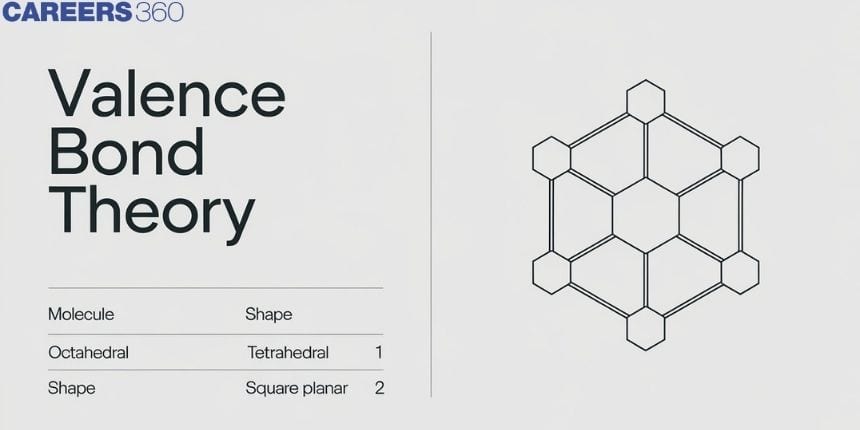Valence Bond Theory of Coordination Compounds
The Valence Bond Theory is the basis upon which a very delicate interaction between metal ions and ligands is represented. The central metal atom or ion is surrounded by molecules or ions called ligands. One of the most important concepts of VBT arises from the ability of the ligand to donate electron pairs to the metal center, thereby forming coordinate bonds.
This Story also Contains
- Interpretation of Coordination Compounds According to VBT
- Weaknesses of VBT
- Some Solved Examples
- Summary

Interpretation of Coordination Compounds According to VBT
According to this theory, the metal atom or ion under the influence of ligands can use its (n-1)d or nd orbitals along with its ns and np for hybridization to yield a set of equivalent orbitals of definite geometry such as octahedral, tetrahedral, square planar and so on. These hybridized orbitals are allowed to overlap with ligand orbitals that can donate electron pairs for bonding. The different types of hybridization and their respective shapes are given below
| Coordination Number | Type of Hybridisation | Shape |
| 4 | sp3 | Tetrahedral |
| 4 | dsp2 | Square Planar |
| 5 | sp3d | Trigonal Bipyramidal |
| 6 | sp3d2 | Octahedral |
| 6 | d2sp3 | Octahedral |
Let us consider the case of [Ni(CN)4]2+ and try to predict the hybridization of this complex
Here nickel is in a +2 oxidation state and the ion has a valence electronic configuration 3d84s
In the presence of Cyanide ions, the electrons will be paired up and the hybridization of Ni in the complex will bed sp2 as shown below

Each of the hybridized orbitals receives a pair of electrons from a cyanide ion. The compound is diamagnetic as evident from the absence of unpaired electrons.
Weaknesses of VBT
While the Valence Bond theory, to a larger extent, explains the formation, structures, and magnetic behavior of coordination compounds, it has some shortcomings which are listed below:
(i) It involves several assumptions.
(ii) It does not give a quantitative interpretation of magnetic data.
(iii) It does not explain the color exhibited by coordination compounds.
(iv) It does not give a quantitative interpretation of the thermodynamic or kinetic stabilities of coordination compounds.
(v) It does not make exact predictions regarding the tetrahedral and square planar structures of 4-coordinate complexes.
(vi) It does not distinguish between weak and strong ligands.
Recommended topic video on(Valence Bond Theory of Coordination Compounds)
Some Solved Examples
Example 1
Question:
The molecule in which hybrid molecular orbitals involve only one d-orbital of the central atom is:
1)[Ni(CN)4]2−
2) BrF5
3)XeF4
4)[CrF6]3−
Solution
Hybridization of the given molecules-
(1)[Ni(CN)4]2−→dsp2
(2)BrF5−Sp3 d2
(3)XeF4−Sp3 d2
(4)(CrF6)3−−d2Sp3
So, in [Ni(CN)4]2− molecule hybrid MOs involve only one d-orbital of the central atom.
Therefore, the correct option is (1).
Example 2
Question:
According to the valence bond theory, the hybridization of a central metal atom is dsp2 for which one of the following compounds?
1)NiCl2⋅6H2ONiCl2⋅6H2O
2)K2[Ni(CN)4] K2[Ni(CN)4]
3)[Ni(CO)4][Ni(CO)4]
4)Na2[NiCl4]Na2[NiCl4]
Solution
Configuration of Ni=[Ar]4s23d8
Configuartion of Ni2+=[Ar]3d8
Thus, Ni2+ has 2 unpaired electrons which can be paired up in the presence of a strong field ligand like CN-as depicted below
Thus, [Ni(CN)4]2− has a dsp2 hybridisation.
Hence, the correct answer is option (2).
Example 3
Question:
In Wilkinson’s catalyst, the hybridization of the central metal ion and its shape are respectively :
1) sp3d, trigonal bipyramidal
2) sp3 tetrahedral
3) dsp2,square planar
4) d2sp3octahedral
Solution:
As we learned in
Hybridization -
sp3d2 - square bipyramidal or octahedral
d2sp3 - octahedral
sp3 - tetrahedral
dsp2 - square planar
wherein
sp3d2 - outer complex
d2sp3 - inner complex
sp3−[Ni(Cl)4]2− dsp2−[Pt(CN)4]2−
sp3−[Ni(Cl)4]2− dsp2−[Pt(CN)4]2−
The Wilkinson catalyst is [RhCl(pph3)3] and the hybridization and its shape are dsp2and square planar respectively.
Hence, the answer is an option (3).
Example 4
Question:
Identify the pair in which the geometry of the species is T-shape and square-pyramidal, respectively :
1)ClF3 and IO4-
2)ICl2-and ICl5
3) XeOF2and XeOF4
4)IO3-and IO2F2-
Solution:
As we learned in
Structure of XeOF2 -
Sp3d hybridized and T-shaped structure
- wherein

Structure of Xenon XeOF4 (oxytetrafluoride) -
Sp3d2 hybridized and square pyramidal structure
- wherein


Summary
In a nutshell, the Valence Bond Theory is maybe one of the most important tools in knowing the bonding and properties of coordination compounds, overhead in scientific and industrial use. In short, VBT describes how the metal ion interacts with ligands to form stable complexes while taking their geometrical arrangement on the principles of hybridization. This theory focuses on the level of strength of a ligand and the hybridization types that give rise to a diversity of structures, instituting tetrahedral and square planar geometries.

